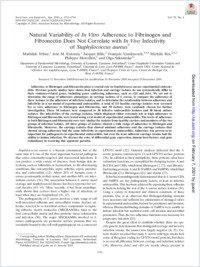Natural Variability of In Vitro Adherence to Fibrinogen and Fibronectin Does Not Correlate with In Vivo Infectivity of Staphylococcus aureus
- Ythier, Mathilde Department of Fundamental Microbiology, University of Lausanne, Lausanne, Switzerland
- Entenza, Jose M. Department of Fundamental Microbiology, University of Lausanne, Lausanne, Switzerland
- Bille, Jacques Centre Hospitalier Universitaire Vaudois and University of Lausanne, Lausanne, Switzerland
- Vandenesch, François Hospices Civils de Lyon, Centre de Biologie Est, Bron F-69500, France
- Bes, Michèle Hospices Civils de Lyon, Centre de Biologie Est, Bron F-69500, France
- Moreillon, Philippe Department of Fundamental Microbiology, University of Lausanne, Lausanne, Switzerland
- Sakwinska, Olga Department of Fundamental Microbiology, University of Lausanne, Lausanne, Switzerland
Published in:
- Infection and Immunity. - American Society for Microbiology. - 2010, vol. 78, no. 4, p. 1711-1716
English
ABSTRACT
Adherence to fibrinogen and fibronectin plays a crucial role in Staphylococcus aureus experimental endocarditis. Previous genetic studies have shown that infection and carriage isolates do not systematically differ in their virulence-related genes, including genes conferring adherence, such as clfA and fnbA . We set out to determine the range of adherence phenotypes in carriage isolates of S. aureus , to compare the adherence of these isolates to the adherence of infection isolates, and to determine the relationship between adherence and infectivity in a rat model of experimental endocarditis. A total of 133 healthy carriage isolates were screened for in vitro adherence to fibrinogen and fibronectin, and 30 isolates were randomly chosen for further investigation. These 30 isolates were compared to 30 infective endocarditis isolates and 30 blood culture isolates. The infectivities of the carriage isolates, which displayed either extremely low or high adherence to fibrinogen and fibronectin, were tested using a rat model of experimental endocarditis. The levels of adherence to both fibrinogen and fibronectin were very similar for isolates from healthy carriers and members of the two groups of infection isolates. All three groups of isolates showed a wide range of adherence to fibrinogen and fibronectin. Moreover, the carriage isolates that showed minimal adherence and the carriage isolates that showed strong adherence had the same infectivity in experimental endocarditis. Adherence was proven to be important for pathogenesis in experimental endocarditis, but even the least adherent carriage strains had the ability to induce infection. We discuss the roles of differential gene expression, human host factors, and gene redundancy in resolving this apparent paradox.
- Language
-
- English
- Open access status
- bronze
- Identifiers
-
- DOI 10.1128/iai.01274-09
- ISSN 0019-9567
- Persistent URL
- https://sonar.rero.ch/global/documents/230934
Statistics
Document views: 16
File downloads:
- fulltext.pdf: 0
